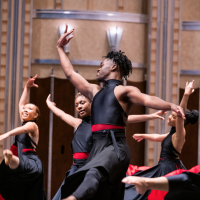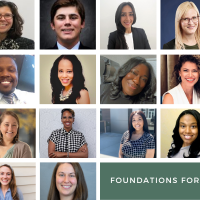The 33,000 acres of protected land between Cleveland and Akron that we know as Cuyahoga Valley National Park (CVNP) was established in 1974 as a part of President Nixon’s “Parks to the People” policy, an initiative created to make national parks relevant to nearby urban populations. Now, CVNP, the only national park in Ohio, is explored by more than 2.5 million visitors each year.*
However, the Conservancy for Cuyahoga Valley National Park (CCVNP) – a nonprofit organization and friends group that exists to inspire use, appreciation and support of CVNP – has found that just because the park is located near diverse communities, doesn’t mean the park’s visitors represent that diversity. Deb Yandala, CEO of CCVNP, explains, “When we’ve done our research, statistics say our visitation by persons of color is quite low. We felt it was time to ask ourselves, ‘How can we do our work better?’ Especially given our location near two urban areas, our park needs to be welcoming to all people and a place where all people can find a sense that this is their national park.”
The Conservancy is addressing barriers to access across all aspects of the organization, from revamping internal culture to creating new community engagement efforts. We asked Yolanda Hamilton, Director of Diversity, Equity and Inclusion (DEI) at CCVNP, and Deb Yandala how their organization is implementing DEI strategies that provide underrepresented populations with opportunities to enjoy greenspace, learn about preservation and build careers in environmental stewardship:
Can you explain the mission of the Conservancy for Cuyahoga Valley National Park?
Deb Yandala: Originally, our group was made of volunteers who fought to protect this land that lies between Cleveland and Akron, people who wanted it preserved as a park for public access. Now at the Conservancy, we work to connect the community with this national park and with environmental issues. We do that via education, volunteerism, overseeing retail stores and leasing buildings from the park services to put into public use. We’re here to support the mission of the National Park Service.
In the past few years, your organization has made diversity, equity and inclusion (DEI) a priority. How do you implement this in your programming?
Yolanda Hamilton: Our diversity, equity and inclusion initiative consists of health equity, environmental justice and education. We wanted to focus on these three areas so we can have more engagement with the communities we serve. As it relates to health equity, we know that the use of green space is very important in terms of improving overall health outcomes related to physical and mental health. Cuyahoga Valley National Park is such a great resource because of the amount of green space we have.
As it relates to environmental justice, it’s so important for the community to recognize the Conservancy as a leading resource. When it comes to health care disparities and food insecurities, we have a wide variety of resources, educational opportunities especially, to reduce barriers in terms of improving health outcomes for the communities we serve. We’re not just located in the park; we are extending our reach to the Cleveland and Akron areas.
As it relates to education, we offer a variety of programs working with the Cleveland Metropolitan School District as well as the Akron Public Schools to expose those students to the park and provide activities in green space, so they can become environmental stewards for the future.
Why is it important to provide programming specific to youth?
Yandala: I am most proud of the work we do with youth. We realize for many children in Northeast Ohio, this might be their only national park experience. We believe learning about the environment and protecting natural resources is a right of all children. It’s going to be important for them as voters and decision makers as adults. That means we do a lot of programming in the park, but also in the city so the kids learn about environmental justice issues right in their neighborhoods.
In 2018, the Cleveland Foundation supported the Conservancy with a $170,000 grant to advance diversity, equity and inclusion in Cuyahoga Valley National Park. What progress has been made with this funding?
Hamilton: With the support we received from the Cleveland Foundation, we have been able to go full force in driving our DEI goals. One prominent program we have launched because of funding from the Cleveland Foundation is our pipeline program, which creates access to opportunities in environmental careers to students from underserved populations. We recognized that we needed to do better in diversifying our recruitment and retention efforts, so as a result, the pipeline program gives opportunities to students from different backgrounds, particularly from historically black colleges and universities, to provide them with a first-hand opportunity for meaningful employment.
During our 2019 Annual Meeting, we asked our Program team to define what makes an “Environment for Success.” How do you define an “Environment for Success” and how does the CCVNP support that vision?
Yandala: I think a successful environment is where all feel that they are welcome and that they have a voice. Our natural environment works best when we recognize the importance of biodiversity. It’s why every species is important and why protecting habitats in the park is important. Biodiversity is an important ecological concept that is true for human beings as well. That means in our organization, everybody is equally important and everybody’s voice is important. It means constantly asking ourselves how we can be better at reaching people and protecting this park.
Hamilton: An environment for success consists of having leadership that is courageous to take on this mantle we have in the community to become an organization focused on DEI. Leadership that stands up to challenge systemic racism and the barriers to access and opportunities that are faced by underrepresented groups. The CCVNP has an executive leadership team that brings these values into our internal culture.
Can you speak about the history of the National Park’s relationship with the Cleveland Foundation?
Yandala: The Cleveland Foundation has long been a funder of Cuyahoga Valley National Park. Earlier leaders of the Cleveland Foundation recognized the economic potential of having a national park in the backyard of Cleveland. They funded projects here, including the establishment of the Towpath Trail, Cuyahoga Valley Education Center, the scenic railroad and the Countryside Initiative program. And those early leaders at the Cleveland Foundation were right; this park attracts a lot of tourists and it’s one of the amenities people in Cleveland talk about as a resource for them. I really appreciate that the present-day leaders of the Cleveland Foundation help us to be better at what we do, push us to be more accessible to more people and help us to think creatively about the work we do. The program officers we work with are really thought leaders and they help us to be better as a nonprofit organization.
Support the Conservancy for Cuyahoga Valley National Park here.
Stay tuned for more “Stories of Impact” in our community throughout 2019 featuring Cleveland Foundation partners and grant-funded nonprofit organizations. Looking to donate to a specific field of interest or begin your own fund to support causes you care about? Visit: www.ClevelandFoundation.org/give.
*nps.gov


